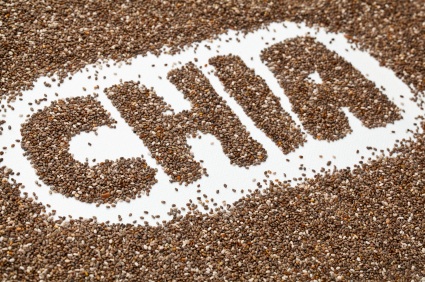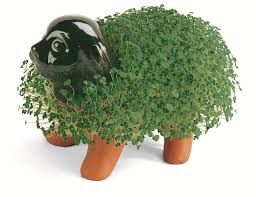Chia Seeds: What's All the Rage?

If you grew up in the 1980’s, you may remember the popular “chia pet” terracotta figurine that would sprout chia. The rage was to watch the “chia pet” sprout and grow a coat of fur or hair in just a couple of weeks. At that time, the chia seeds health food benefits were not popularized like the pet figurine novelty.

What are Chia Seeds?
Chia seeds are members of the mint family. They are tiny black and white seeds that come from the Salvia hispanica plant, grown in Mexico and South America. They have a long history of use by the Mayan and Aztec cultures for supernatural powers.
What is Chia Seeds “claim to fame?”
With the prevalence of obesity, cancer and heart disease, this potential “superfood” when used on a daily basis, claims to help control hunger, reduce blood glucose levels, reduce the inflammation linked to cancer, and reduce heart disease. In addition, chia seeds have been sought out by consumers for their ability to treat wrinkles and dry skin, boost cognition, and support bone and joint health (well-known benefits of omega 3- fatty acids).
Clinical trials are limited for proving that chia seeds reduce heart disease. Although three out of four clinical studies have shown positive effects for weight loss, improved omega 3-fatty acid levels, and reduced triglyceride and blood glucose levels, sample sizes of these clinical trials were small and other aspects of the studies limit the degree of generalizing the results. More research is needed to determine if chia seeds can truly meet these claims. However, understanding that chia seeds boost more antioxidants than blueberries, and are the highest known plant source of omega-3 fatty acids (alpha-linolenic acid [ALA]), and contain such a large amount of health benefiting fiber, it would be negligent to not incorporate this nutrition powerhouse into a daily diet, knowing of all the health benefits for ALA and fiber. Chia seeds are also a high source of energy and can be a versatile food for runners since their liquid absorbing properties encourages a slower release of fluid, thereby improving hydration status. This is definitely a unique, versatile and powerful food.
What makes Chia Seeds a nutrition “powerhouse?”
A one-ounce serving (2-Tablespoons) contains:
138 calories
9 grams fat
10 grams fiber
5 grams protein
18% Daily Value for calcium
4,500 mg per ounce of alpha-linolenic acid (omega 3-fatty acids)
Chia seeds are also rich in iron, boron, magnesium, phosphorus, and zinc. Chia seeds can theoretically help control hunger due to their ability to swell and form a gel when combined with liquid. The chia seed is hydrophilic (water-loving), and can thus soak up 12 times its weight in water. Its high omega 3-fatty acid content (more than flaxseed and salmon) makes it an excellent heart healthy food for reducing risk of heart disease, especially when combined with other heart-healthy practices. Chia seeds also contain 3 times the fiber of that found in a slice of whole wheat bread. Chia seeds are a complete plant protein, making it an excellent choice for those who eat vegan and vegetarian. Chia seeds are also useful to those who eat gluten-free or who have allergies to eggs, since its cooking characteristics or so versatile. Chia seeds can be eaten raw, cooked into foods, and easily added to many foods since they so easily absorb liquid.
How do Chia Seeds taste and how are they used?
Chia seeds have a mild, nutty flavor, similar to flaxseeds. Unlike flaxseeds, however, chia seeds can be eaten whole as well as ground. Chia seeds go well with both sweet and savory foods and add more crunch and texture to foods, without changing the foods flavor. When mixed with beverages or puddings, the suspended seeds are more for presentation (and health) than for flavor. One popular beverage in the Mexican and Central American culture is chia fresca, where chia seeds are mixed into lime or lemon juice, along with added sweetener. Chia seeds can be added to any liquid to make a chia seed gel. To make the seeds taste like orange juice, soak them in orange juice, or to make them taste like tomato soup, soak them in tomato soup—you get the idea.
Who should NOT eat Chia Seeds?
People who are sensitive to mustard, oregano, thyme or sesame seeds may also have a reaction to chia seeds, although this is rare. People who are on blood thinners or other heart medications should check with their healthcare providers before eating chia seeds, due to possible food/drug interactions, but no known adverse reactions or interactions with other drugs, food, herbs or supplements have been reported. There has been some evidence that high intakes of ALA may increase risk of or worsen existing prostate cancer. The mechanism for this is unknown, therefore, until more evidence is available, large quantities of chia seeds and other ALA-rich foods should be avoided in men diagnosed with prostate cancer or at high risk of prostate cancer.
Purchase the Cardiometabolic, Omega-3 Fatty Acid & Insulin Profile
How to use Chia seeds for improved nutrition & health:
- Sprinkle the whole or ground chia seeds into hot or cold cereal, smoothies, cottage cheese, salads, yogurts or puddings
- Make a gel to bind veggie patties, meatloaf/meatballs instead of eggs or breadcrumbs
- Thicken soups or sauces
- Use the gel to replace or reduce oil in baked dishes or salad dressings
- Mix ground seeds into flour for muffins, cookies and cakes
- Add to scrambled eggs to add fluffiness or to gluten-free products, e.g. waffles, pancakes to increase fluffiness
- Substitute one tablespoon of chia seed gel (one part chia seeds to three parts water) for one large egg in baked products
- Use the gel to displace foods, such as yogurt if you want to eat less of that food, while also providing insoluble fibers that are also filling (thus keeping hunger pangs more at bay)
- Mix with nut butter for a spread on toast
- Make an ice cream topping by making a gel with fruit juice instead of water
How are Chia Seeds purchased and stored?
Chia seeds are usually sold in bulk 10-pound bags, but smaller quantities are available. Thanks to their amazing antioxidant content, chia seeds have a long-shelf life (about 3 months) and do not go rancid as quickly as flaxseeds. They should be stored in a cool, dry place. If the chia seeds are ground, they should be placed in a container with a tight-fitting lid, for no more than a month, and if storing chia seed gel, keep in the refrigerator for about two weeks.
Ch-ch-ch-chia!
This was the catchphrase sung in a stuttering fashion on the television commercials in the 1980s, advertising the “chia pet.” Perhaps we can use this same excitement and sing the nutritional and health benefits of chia seeds. Ch-ch-chi-chia!
References:
Chia Seeds: Tiny Seeds with a Rich History. Food & Nutrition; Jan/Feb 2014; Kerry Neville, MS, RD
Chia: An Underappreciated Source of Omega-3 Fatty Acids. Dietitians in Integrative and Functional Medicine, ADA Newsletter; Spring 2011, Vol 13, Issue 3; Jacqueline Santora Zimmerman, MS, RD

